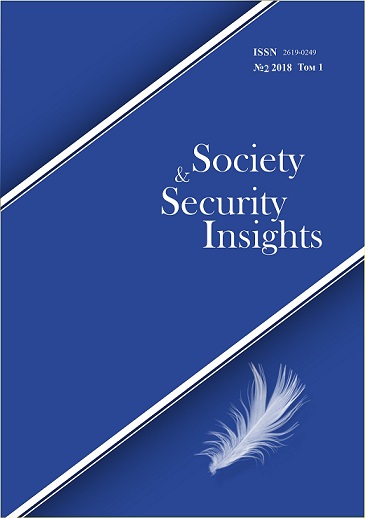THE MODEL OF ETHNIC IDENTITY OF POPULATION FROM BORDER REGIONS OF RUSSIA
Main Article Content
Abstract
The article presents the results of ethnic identity modeling, based on the data from sociological surveys in 9 border regions of Russia (Republic of Karelia, Orenburg oblast, Omsk oblast, Altai krai, Novosibirsk oblast, Republic of Altai, Amur oblast, Jewish autonomous oblast and Transbaikal krai) conducted in 2015-2017 by the group of scientists from the Altai State University (n= 4437, aged from 15 to 75 years). The proposed model is defined by socio-demographic characteristics, actual state of inter-ethnic relations, effectiveness of realization of State policy on nationalities in the region. The ethnic identity is measured directly through its emotional, cognitive and behavioral components; the model has unidirectional causality, that is the extent of each component can lead to an increase in ethnic identity expression. The grouping of regions based on differences in proportions of ethnic groups allowed to fulfil regional comparisons. The analysis of the proposed model shows that inter-regional differences in ethnic identity formation are largely connected with ethnic composition of the region.
Downloads
Metrics
Article Details
Authors retain the copyright of their manuscripts, and all Open Access articles are distributed under the terms of the Creative Commons Attribution License, which permits unrestricted use, distribution, and reproduction in any medium, provided that the original work is properly cited.
References
Berry J.W. Immigration, Acculturation, and Adaptation. Applied psychology: an international review, 1997, 46 (1), 5–34.
Brednikova O., Voronkov V. Border and Social Space Restructuring (The Case of Narva-Ivangorod). In: Nomadic Borders. Proceedings of the Seminar Held in Narva (12-16 November 1998). St. Petersburg: CISR. Working Papers no 7, 1999. pp. 104–110.
Cebotari V. Civic, ethnic, hybrid and atomized identities in Central and Eastern Europe. Identities, 2016, 23:6, 648-666. doi: 10.1080/1070289X.2015.1059338
Faranda R., Nolle D.B. Boundaries of ethnic identity in Central Asia: titular and Russian perceptions of ethnic commonalities in Kazakhstan and Kyrgyzstan. Ethnic and Racial Studies, 2011, 34:4, 620–642. doi: 10.1080/01419870.2010.516004
Hansen H.E., Hesli V.L. National Identity: Civic, Ethnic, Hybrid, and Atomised Individuals. Europe-Asia Studies, 2009, 61:1, 1–28. doi: 10.1080/09668130802532894
Kolosov V.A., Klemeshev A.P., Zotova M.V., Sebentsov A.B. Russia-European Union Borderlands: Transboundary Gradients, Interactions and Current Challenges. International Journal of Economics and Financial Issues, 2015, 5 (Special Issue), 5-12.
La Barbera F., Capone V. Five Dimensions of European Identity: A Contribution to the Italian Adaptation and Validation of the In-Group Identification Scale. Europe’s Journal of Psychology, 2016, vol. 12(2), 288–303. doi:10.5964/ejop.v12i2.1058
Lazić M., Pešić J. Components of national identities — a comparative sociological analysis. Corvinus journal of sociology and social policy, 2016, vol. 7: 1, 27-49. doi: 10.14267/CJSSP.2016.01.02
Maximova S., Noyanzina O., Omelchenko D., Goncharova N., Maximov M., Surtaeva O. Sociological monitoring of interethnic relations. Procedia — Social and Behavioral Sciences, 2016, 219, 534–540. doi: 10.1016/j.sbspro.2016.05.031
Noyanzina О., Maximova S., Goncharova N., Omelchenko D., Avdeeva G. Interethnic Generalizations and Stereotypes In Mental Representations of Image of ‘The Other’ in Social Representations of Russian Population. Procedia — Social and Behavioral Sciences, 2015, 185, 179–184. doi: 10.1016/j.sbspro.2015.03.425
Örkény A., Székelyi M. Constructing border ethnic identities along the frontier of Central and Eastern Europe. Identities, 2016, 23:6, 667-685. DOI: 10.1080/1070289X.2015.1059342.
Paat, Y.-F., & Pellebon D. (2012). Ethnic Identity Formation of Immigrant Children and Implications for Practice. Child & Youth Services, 33:2, 127–145. doi: 10.1080/0145935X.2012.704785
Phinney J.S., Ong A.D. Conceptualization and Measurement of Ethnic Identity: Current Status and Future Directions. Journal of Counseling Psychology, 2007, vol. 54, no 3, 271–281. doi: 10.1037/0022-0167.54.3.271
Phinney J.S., Horenczyk G., Liebkind K., Vedder P. Ethnic identity, Immigration, and Well- Being: An Interactional Perspective. Journal of Social Issues, 2001, vol. 57, no 3, 493–510.
Schönpflug U. Acculturation, Ethnic Identity, and Coping. Online Readings in Psychology and Culture, 2002, 8(1). http://dx.doi.org/10.9707/2307-0919.1068
Waechter N. Introduction to the construction and the interplay of European, national and ethnic identities in Central and Eastern Europe. Identities, 2016, 23:6, 630–647. doi:10.1080/1070289X.2015.1059343.

